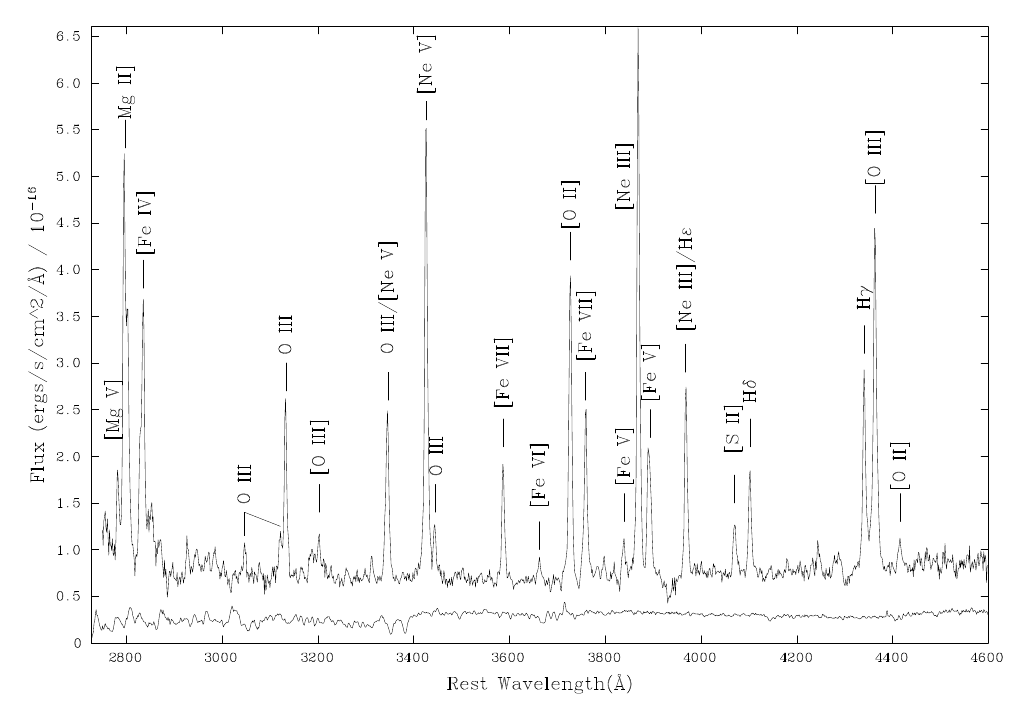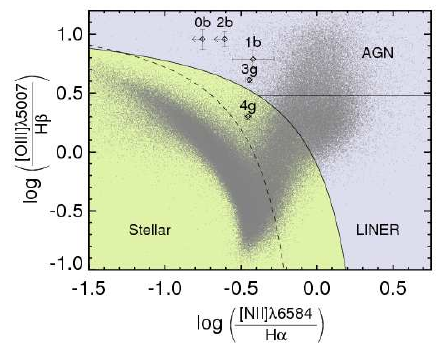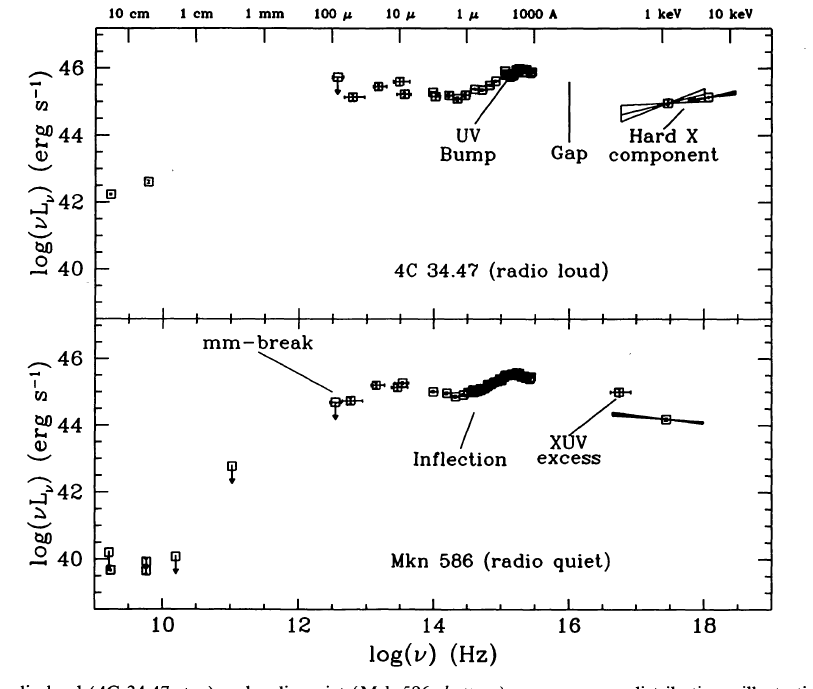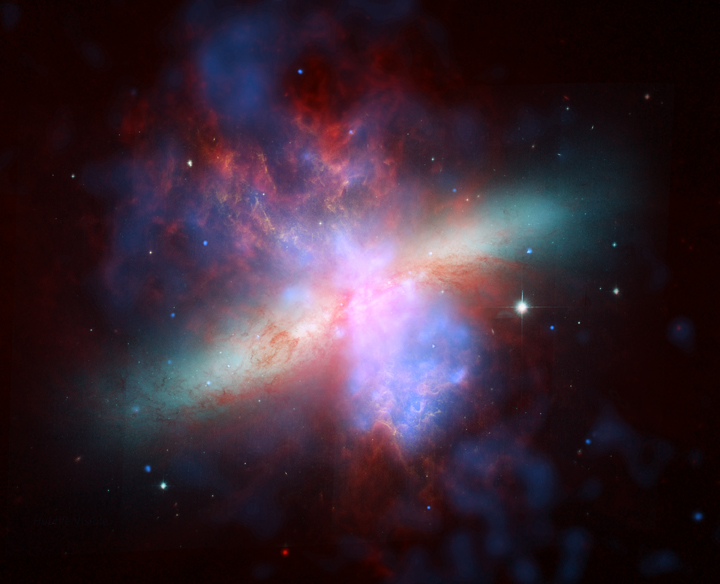| Barred spiral galaxy: |
A spiral galaxy with a bar-shaped distribution of stars in the center, including the Milky Way. The gravitaitonal potential of the bar introduces many interesting dynamic effects (e.g. arXiv:1102.1157) and may prompt star formation (see this Astrobite). |
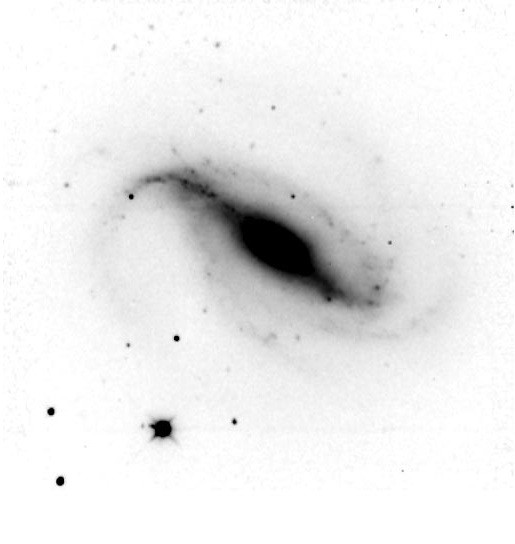 The strongly barred spiral galaxy NGC 613 viewed in the infrared (from 2000AJ....119..536E). |
| Blue Compact Dwarfs (BCDs): |
See LCBGs. |
| Blue Compact Galaxies (BCGs, not to be confused with Brightest Cluster Galaxies): |
These are intermediate-mass ( , ,  ), low-metallicity, star-forming galaxies that often appear to be interacting with other galaxies or merging. They are starbursting in the sense that they have strong emission lines and they have bright, young clusters with ages <5 Myr.They are considered to be analogs of higher-redshift Lyman Break Galaxies. They are therefore useful tracers of galaxy evolution. See arXiv:1103.5771. ), low-metallicity, star-forming galaxies that often appear to be interacting with other galaxies or merging. They are starbursting in the sense that they have strong emission lines and they have bright, young clusters with ages <5 Myr.They are considered to be analogs of higher-redshift Lyman Break Galaxies. They are therefore useful tracers of galaxy evolution. See arXiv:1103.5771. |
 HST image of BCG Mrk 930, demonstrating faetures of interaction. From Figure 1 of arXiv:1103.5771. |
| Brightest Cluster Galaxy (BCGs, not to be confused with Blue Compact Galaxies): |
This is simply the galaxy that happens to be the brightest among its galaxy cluster. The BCG is typically a giant elliptical located in the center of the cluster. Because BCGs across all clusters of a given size tend to be of similar brightness, they have been used as standard candles. |
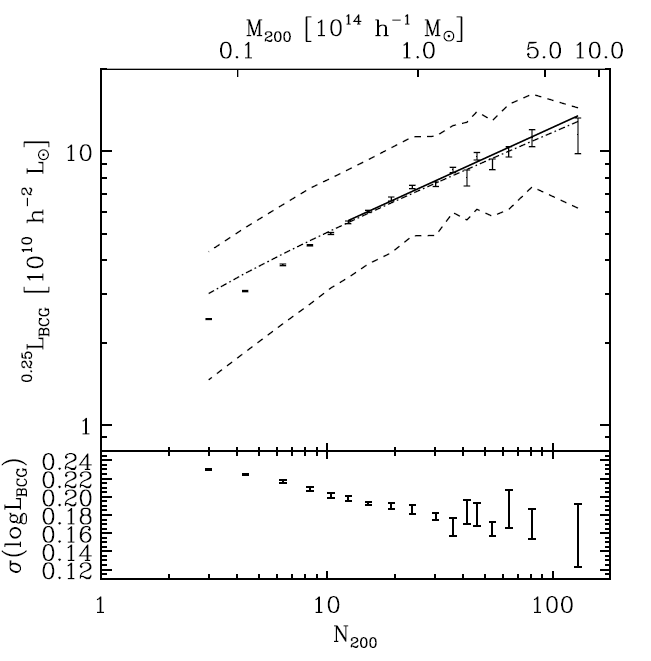 The dependence of the brightness of a BCG on the richness of the cluster (number of galaxies above a certain brightness),and its scatter (below). From 2009ApJ...699.1333H |
| Bright Red Galaxies (BRGs): |
Synonymous with luminous red galaxies (LRGs). |
| cD galaxies: |
Enormous (“supergiant”) early-type galaxies (sometimes r>1 Mpc), typically found at the center of clusters. Their outer brightness profiles (“envelopes”) extend so far that it can be difficult to distinguish them observationally and dynamically from their cluster neighbors. See e.g. 1988ApJ…328..475S. |
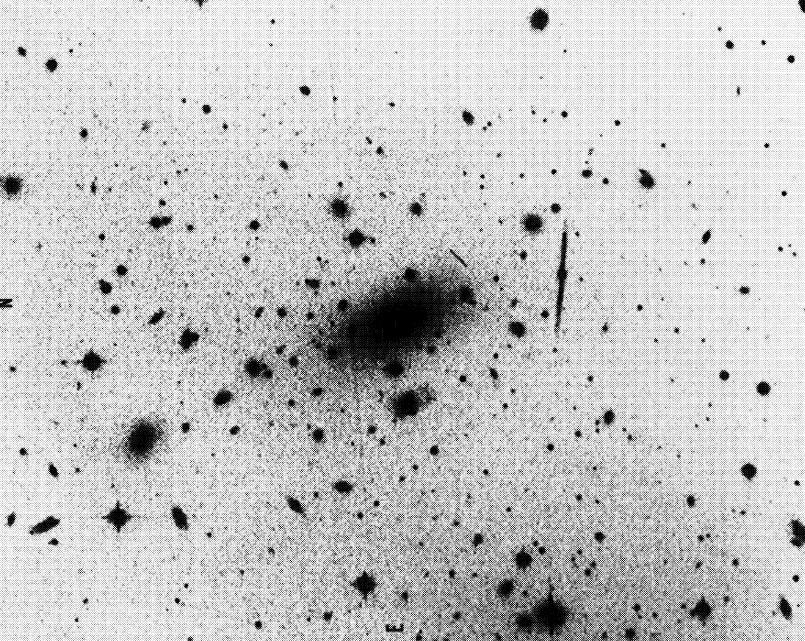 The central 300 kpc of the cluster Abell 2029 and its cD galaxy. From 1979ApJ...231..659D |
| Compact elliptical (cE) galaxies: |
Possibly formed when a more massive early-type spiral galaxy is tidally-stripped by a larger neighbor on a timescale of ~1 Gyr. The luminosity of the galaxy may change dramatically during this process, while the color will not, so cEs may appear an order of magnitude dimmer than similarly red galaxies. See e.g. arXiv:1102.1159 |
| Compact Narrow Emission Line Galaxies (CNELG): |
A subset of Luminous Compact Blue Galaxies with narrow emission line features. See LCBG. |
| D galaxies: |
|
| Dwarf galaxies: |
Dwarfs generally have little gas, have old stellar populations, and smooth, featureless morphologies that are supported by pressure from random stellar motion. However, this is a diverse class: see other entries for dwarfs on this page, arXiv:1101.2460, and arXiv:1103.1116. |
| Dwarf irregular (dIrr) galaxies: |
Dwarf irregulars are interesting laboratories for galaxy evolution, because they do not have dynamical features such as spiral density waves that interfere with the fundamental role of fundamental processes such as turbulence and stellar evolution in driving star formation. However, it has been shown that dIrrs can undergo long-duration (>1 Gyr) starbursts. See e.g. arXiv:1104.0464. |
| Dwarf ellipticals (dE): |
Generally the most massive dwarfs, dominated by stars rather than dark matter in their inner regions. They have low gas fractions nad metallicities (Z ~< 0.1 Z_solar). These are common in the universe and dominate cluster populations, but there are only three known in the Local Group (interacting with Andromeda). This suggests that dE formation is strongly environment-dependent (see e.g. arXiv:1101.2460 and arXiv:1103.1116). |
| Dwarf spheroirdals (dSph): |
Smaller dwarfs that are dominated by dark matter rather than stars in their central regions. These are ubiquitous in the Local Group (>20 already known), interacting tidally with larger galaxies. They are potentially valuable probes for studying dark matter. It’s unclear if low mass dSph galaxies can be distinguished from globular clusters. See e.g. arXiv:1101.2460, arXiv:1103.0477, and arXiv:1103.1116. |
| E+A galaxies (“Poststarburst” galaxies, PSGs): |
Have strong Balmer absorption lines typical of young stars, but lack optical emission features (e.g. O III 5007) typical of star-forming regions and have metallic absoprtion lines (e.g. Ca H and K) indicative of an older population of dwarf stars. The presence of two distinct stellar populations and morphological observations suggest that E+A galaxies are the product of a gas-rich galaxy merger (see e.g. 2000AJ….119.2118G and arXiv:1101.4933) |
| Early type: |
Refers to galaxies on the left side of Hubble’s tuning fork diagram – often synonymous with elliptical galaxies (see concepts PDF). |
| Elliptical: |
Galaxies typified by a spheroidal distribution of stars, rather than a disk. These are typically “red” and “dead,” with little ongoing star formation. |
| Faint blue galaxies: |
|
| Faint low surface brightness galaxies (fLSBs): |
Galaxies with a central surface brightness fainter than 24 mag/arcsec^2, but a total r-band magnitude > 21. Because these galaxies are often too faint to be seen, they have been suggested as a contributor to the “missing dwarf problem,” where cosmological models predict more small galaxies than are observed. See arXiv:1101.4136 |
| Giant ellipticals (gE): |
|
Green Pea galaxies (GPs): |
Very compact (~1-2 kpc half-light radius), low-mass starbursting galaxies in the nearby (z<1) universe that are intermediate in color between early and late type galaxies (green). These may represent high-luminosity blue compact galaxies. GPs are generally metal poor (oxygen abundance ~20% solar), but are relatively enriched in nitrogen. |
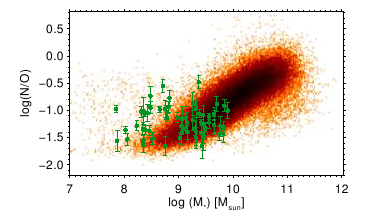 Green pea galaxies (green dots) are nitrogen-enriched compared to most galaxies (density plot) of the same oxygen abundance. From Amorín et al. 2011 (arXiv:1105.1477). |
| Green valley galaxies: |
A small population of galaxies somewhere in between red (late type) and blue (early type) galaxies in the bimodal distribution of galaxy types. It is not clear whether these galaxies are simply outliers among the early and late type distributions, are in transition between the two populations, or are another class of galaxy alltogether. These galaxies tend to have AGN or stellar bars which could be responsible for quenching star formation and causing them to transition from early to late type. See e.g. arXiv:1101.3353 or the 4/5/2011 Astrobite. |
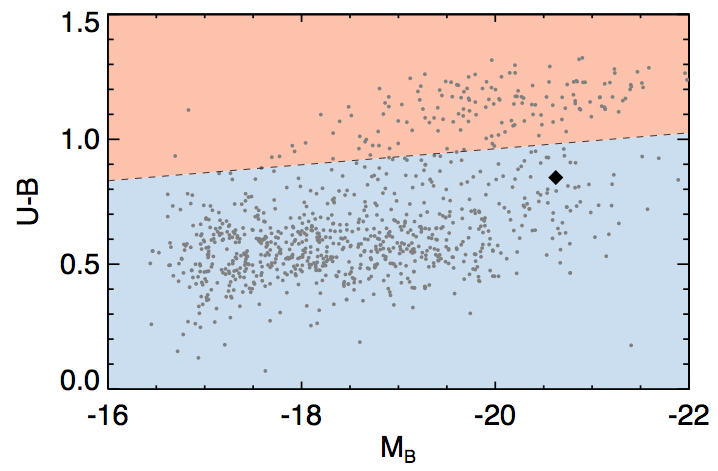 Figure 2: A color-magnitude diagram that shows the "red sequence", "Blue Cloud", and less populated "Green Valley". |
| HII galaxies: |
Gas-rich, metal-poor dwarfs undergoing a period of star-formation that dominates its optical spectrum such that it is easily confused for a giant HII region. The galaxy itself is generally low-luminosity (M_V~-17), but there are very bright ~100pc knots in the center. The starburst is thought to last ~1 Gyr. (See e.g. arXiv:1101.4140) |
| H-alpha emitters (HAWs): |
Galaxies that have emission at the Balmer line H-alpha, usually found via narrow-band imaging surveys tuned to a given redshift. H-alpha emission is typically associated with star formation. See e.g. arXiv:1104.3608. |
| Irregular galaxies: |
|
| L* and M* galaxies: |
There is a “knee” in the luminosity function of galaxies that suggests a dividing a line between very bright and less bright galaxies (with L* in between) and very massive and less massive (with M* in between). Galaxies with L~L* are typically M* galaxies and vice versa. The Milky Way is roughly an M* galaxy. |
| Late type galaxies: |
Refers to galaxies on the right side of Hubble’s tuning fork diagram – essentially a synonym for spiral galaxies (see concepts PDF). |
| Lenticular galaxies (S0): |
These are galaxies that fall between spirals and ellipticals on the Hubble sequence, exhibiting both an old, spherical population and traces of a disk. Originally thought not to contain gas, but some have been found to be gas-rich (see e.g. 1991A&A…243…71V or arXiv:1101.5092). |
| Low surface brightness galaxies (LSBs): |
Galaxies with a low surface brightness (e.g. that are not bright for a given area in square arcseconds). The low surface brightness is associated with a low gas surface density. Curiously, these galaxies seem to follow a different star formation efficiency law than the normal Kennicut-Schmidt law. See e.g. arXiv:1103.3711 and also see fLSBs. |
| Luminous Blue Galaxies (LBGs): |
|
| Luminous Compact Blue Galaxies (LCBGs): |
Galaxies that are bluer (have more star formation) than their small size (half-light radius) would indicate and as bright or brighter than the Milky Way. They are common at z~1, but rare in the local universe, suggesting that this is a vigorous stage of evolution. One possible formation mechanism is the merger of a dwarf elliptical with a gas rich source which could provide fuel for star formation, such as another dwarf galaxy or an HI cloud. See e.g. 2004ApJ…617.1004W and arXiv:1103.0526 |
| Luminous Red Galaxies (LRGs): |
Very luminous (~3 L^*) early-type galaxies, essentially giant elliptical galaxies. The brightest galaxies in clusters are typically LRGs. LRGs are ofted used to probe hierarchical galaxy formation and the SDSS LRG survey produced a conclusive detection of the baryon acoustic oscillations (BAO). See e.g. 2001AJ….122.2267E. |
| Lyman Alpha Emitters (LAEs): |
Strong Lyman alpha emission from star formation, an AGN, or gas infall allows these to be detected at high z (>3). They are traditionally thought of as galaxies in an early burst of star formation, with young stellar populations, very little dust (Av 2.5) and are good tracer sof galaxy evolution. It has been suggested that they can evolve to become Milky-Way like galaxies. See e.g. arXiv:1101.3017 and arXiv:1101.3321. |
| Lyman break analogs (LBAs): |
Local-universe (z < 0.2) equivalents of LBGs, very bright in the far-UV due to high star formation rates. They are similar to LBGs in their metallicity, morphology, radio emission, extinction, etc. See arXiv:1102.1740 and see also Blue Compact Galaxies. |
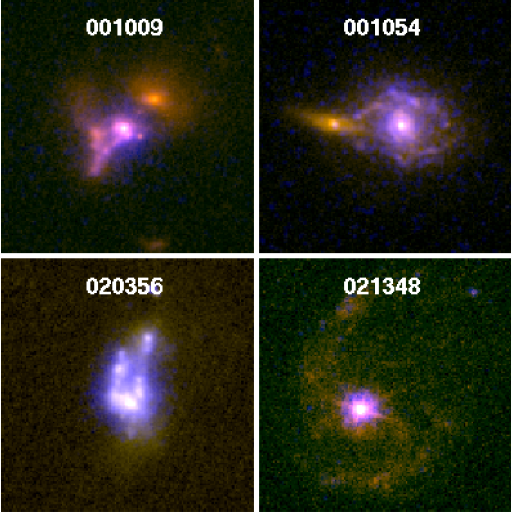 HST rest-frame UV/optical images of LBA candidates. From 2009ApJ...706..203O |
| Lyman break galaxies (LBGs): |
Starburst galaxies at z>2 which can be detected very efficiently by their unique spectral signature near the Lyman-alpha line at 912 Angstroms (UV, redshifted into the optical). This signature is the product of intense Ly-alpha emission, minimal dust extinction from the ISM, and a discontinuity due to absorption from the atmospheres of massive stars and neutral hydrogen in the ISM. See 2002ARA&A..40..579G. |
| Polar Ring Galaxies (PRGs): |
Galaxies that appear to have a disk of gas oriented perpendicular to their stellar disk. In some cases (e.g. IGV 7576, at right), kinematic investigations indicate that the gas disk is actually a ring. Several formation scenarios have been suggested, including a major merger, tidal accretion from a dwarf satellite or nearby spiral, or “cold accretion” of primordial integalactic gas along very long (~1 Mpc) filaments. See e.g. arXiv:1104.2052. |
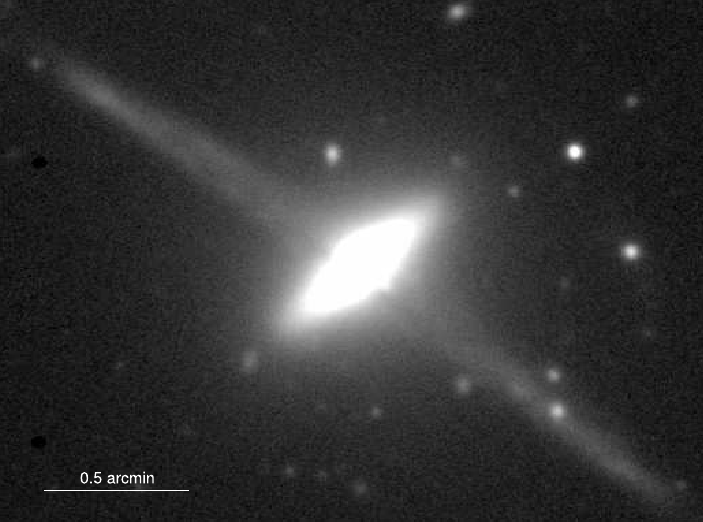 The PRG UGC 7576 in the R band, from Spavone et al. 2011 (arXiv:1104.2052). The gas ring extends from the top left to the bottom right. |
| Pseudobulge galaxies: |
The term pseudobulge refers to a feature that looks like the central, spheroidal, “classical” bulge feature common to spiral galaxies, but is different in some significant way. One definition is a central brightening of the disc that is not extended vertically. Galaxies with pseudobulges have become of great interest because they seem to fall outside of the traditional velocity dispersion – supermassive black hole mass relationship ($M_{BH} – sigma$). The presence of a pseudobulge seems to be associated with a strong bar feature and pseudobulges and classical bulges can both be present in the same galaxy. See e.g. arXiv:1103.0525. |
| Quiescent galaxies: |
These are simply galaxies that are not observed to have ongoing star formation. |
| Satellite galaxies: |
Smaller galaxies gravitationally bound to a larger primary galaxy. Usually this refers to satellites of an isolated galaxy as opposed to members of a large cluster. The “missing satellites problem” refers to the disparity between the large number of satellites predicted by ΛCDM cosmological simulations and the relatively small number of satellites observed (see e.g. arXiv:1101.2674) |
| Spiral galaxies: |
The most common type of galaxy (as defined by a magnitude-limited survey of the local universe). Named for the apparently spiral structure of their thin-disk stars, caused by stellar density waves. They may also have nuclear spheroidal population (bulge) and an extended spheroidal population (halo). Spiral galaxies typically have ongoing star formation, particularly in their spiral arms. The Milky Way is a spiral galaxy. |
| Starbursting dwarf galaxies (SBDGs): |
Dwarf galaxies with gas fractions and star formation rates on the order of giant spiral galaxies (implying the gas will be consumed in less than a hubble time), but low metallicity. It may be that galactic winds carry away heavy elements formed in the galaxy out of its shallow potential well. See e.g. arXiv:1103.1116. |
| Starburst galaxies: |
A generic term for galaxies with regions undergoing a high rate of star formation that is roughly as luminous as the rest of the galaxy combined. Starburst phases are often short-lived (the starburst is highly variable). See also SMGs and ULIRGs. (See e.g. arXiv:1101.4140) |
| Sub-Millimeter Galaxies (SMGs): |
These are among the most vigorously star-forming galaxies in the universe (1000 Msol/yr), are very bright (L~10^13 Lsol), and typically found at high redshift (z~2.5). They are perhaps the result of mergers of gas-rich galaxies and are the progenitors of the massive ellipticals in the local universe. This phase of evolution apparently lasts only ~100 Myr. See e.g. 2008ApJ…680..246T. |
| Tadpole galaxies: |
|
| Tidal Dwarf Galaxies (TDGs): |
Dwarf galaxies that are created from material stripped from larger galaxies rather than simply clouds collapsing in small halos, proposed by Zwicky in 1956. Unlike other dwarf galaxies, TDGs could have no dark matter halo and may be metal rich because they are formed from the recycled material of more massive galaxies. They range from $sim 10^7-10^9 M_odot$, with larger TDGs typically formed by accumulation at the tip of tidal tails. Tidal interaction can cause starbursts in TDGs, and smaller TDGs may be easily disrupted by their parent galaxies, living <10 Gyr. See eg. arXiv:1103.2546. |
 Tidal dwarf galaxies (boxed in red) identified in the tidal tail of TDG 45115, from arXiv:1103.2546 |
| Ultra-compact dwarfs (UCDs): |
These are similar to dSph/dE/cE galaxies, but more compact. Some UCDs are perhaps more like massive globular clusters than small galaxies and have been called giant globular clusters (GGCs). It is proposed that other UCDs are the remnant nuclei of galaxies which have been tidally stripped by more massive neighbors (see e.g. arXiv:1101.2460 and arXiv:1102.0001). |
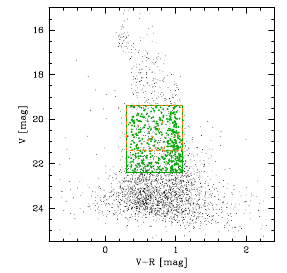 UCDs (boxed in green) are intermediate in brightness between brighter dwarf elliptical galaxies and dimmer globular clusters. This is a color-magnitude diagram of extended sources in the Hydra 1 cluster from Figure 2 of arXiv:1103.5463. |
| Ultra-Luminous Infrared Galaxies (ULIRGs): |
Galaxies with far-IR L(8-1000 microns) > 10^12 L_solar due to dust heated by young stars and, in about half of known ULIRGs, an AGN. These are perhaps the local-universe (z~2) analogy to SMGs, being galaxies with very high star formation rates. They are typically galaxies undergoing major mergers (a collission between two galaxies of similar mass) and are thought to represent a transitionary phase between gas-rich spirals and ellipticals. See e.g. arXiv:1101.5262 and arXiv:1102.1974. |
| Void galaxies: |
Galaxies that are found in voids, the nominally-empty tens-of-Mpc regions of space in the large scale structure of the universe. These essentially isolated galaxies comprise only about 7% of all galaxies. They are generally blue (star-forming, or “young”) and gas-rich. They are valuable tracers of the dependence of galaxy evolution, and especially gas accretion, on environment, See e.g. arXiv:1101.4187, arXiv:1103.4156, and arXiv:1103.5798. |
| Wolf-Rayet (WR) galaxies: |
These are simply galaxies which have recently undergone a starburst such that they exhibit spectral signatures of Wolf-Rayet stars (massive stars with strong mass loss). The existence of WR stars limits the timeframe since the starburst to roughly 2<t<5 Myr. See e.g. 2010A&A…517A..85L |











